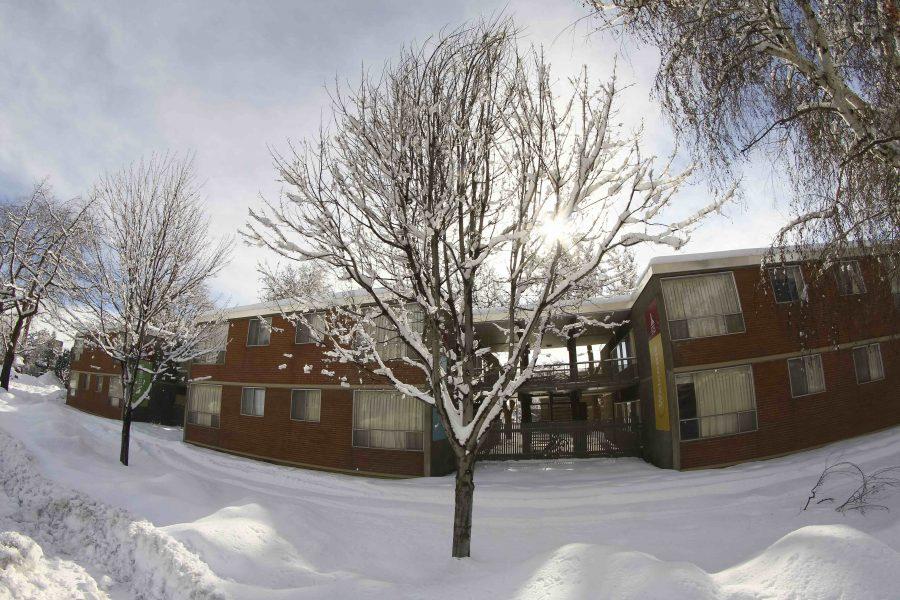Short on repairs
Winter weather impacts student housing
February 23, 2017
Heavy rainfall onto compact snow and ice, followed by a quick inspection of the ceiling, made for one interesting night for a CWU student just last month.
“I had a few people over, just hanging out, doing our thing, and I sat down on my bed for whatever reason and there was this massive puddle,” said Rune Torgersen, a junior communication major. “I figured, OK, someone obviously spilled something … But then my head started getting wet, things were dripping on me.”
Torgersen lives in the Getz-Short apartment complex on the southwest side of campus, which was built in the 1960s and last renovated in September 2015.
The dripping began on Jan. 9, 2017, inauguration night, after one of the first big snowstorms of the quarter. It hasn’t stopped since.
“I looked up and one of my tiles was sort of swollen and little drops of water were coming out of it,” Torgersen said. So he moved his bed to the corner and called maintenance.
“This was a shitty karma day for Rune,” Torgersen said. “I’d think about the good times when my bed was next to my phone charger. I’d think about the good times when I wouldn’t get dripped on in my sleep.”
Bill Yarwood, executive director of facilities management, was contacted last Thursday Feb. 16, by email and phone to comment for this story. Shane Scott, from Yarwood’s office replied in an email that Thursday and the next Tuesday, Feb. 21, that Yarwood “is spread too thin right now.”
In a 2014 Observer story, Yarwood said the Getz-Short roof showed clear signs of wear. At that time, the most recent re-roofing took place in 1971, 44 years before the 2015 repairs.
Lauren Smith*, another resident of Getz-Short, had a similar leaky ceiling last winter.
Luckily, maintenance was able to quickly fix the leak, she said, although she needed a bucket in her room for a short amount of time.
“I’ve never had a problem” with maintenance, Smith said. “They’re always very prompt.”
Torgersen was not as lucky when maintenance promptly responded the morning after the leak began.
Unfortunately, they couldn’t patch the roof due to the nearly two feet of concealing snow; even if they could locate the leak, they told him, it would have to wait until they could repair the concrete crack in the roof.
In the meantime, maintenance rigged a temporary solution. Two wood blocks secure a plastic sheet to the ceiling, which forms a makeshift drain. This diverts the slow dripping into a bucket in the center of Torgersen’s room.
“Even though it seems like a weird Rube Goldberg-esque solution to a simple problem, it’s functional,” Torgersen said. “I believe that maintenance did everything they could.”

An exterior view of the Getz-Short buildings off of University Way shows the heavy accumulation of snow.
Other Issues
These residents said the old, aluminum-framed, single-pane windows are also an issue.
Smith said condensation often gathers on the interior and freezes on the inside. She’s also worried about the interior moisture causing mold.
“They’re super old and when you open and close them it sounds like a machine gun going off,” she said. “It scares everyone.”
Torgersen’s window froze over one morning this quarter. “I couldn’t open it or close it or anything,” Torgersen said. “It was unfortunate, too, because it was open when it froze and that was back when it was negative a billion degrees out.”
The 2015 renovations gave residents new kitchen and bathroom fixtures, fresh paint, and updated appliances, according to a CWU press release.
“My fire alarm goes off literally every time I cook food,” Smith said. “You have to stand there and wave a blanket in front of it until it turns off.”
The apartments look rundown after a year and a half of wear, according to residents.
Some of Smith’s friends call her building Chernobyl. She said thinks new paint and windows would go a long way.
“Slapping some ‘welcome’ signs on the side of the building isn’t going to do much,” Smith said. “I know the university would save a lot of money on heating if they would replace the windows next.”
Not their fault
Residents say they don’t blame the apartments nor the maintenance staff.
Torgersen stressed the fact that he thinks maintenance is doing the best they can with what they have.
Smith said, “Tell maintenance to keep up the good work, because I appreciate them, I really do,” Smith said.
About 180 students live in the two-building complex. And with a record number of freshmen arriving on campus last September, maintenance could conceivably be stretched thin.
Maintenance spent the summer keeping the campus “clean, repaired and manicured, Gaudino said in his State of the University address last week.
In an email request for an interview, Richard DeShields, associate dean of student living, was told the Observer wanted to talk about dorms being converted from singles and doubles to house more students, and was asked if his office was “aware of the damages in the halls.”
In an email reply, DeShields didn’t address the interview request nor the question about the damages.
He said they had just opened up housing applications for new students and were expecting 50-100 extra first-year students. No dorms would convert to triples from doubles.
“By increasing Davies Hall [to doubles] and continuing use of Munson, we will meet this need,” he said.
Editor’s Note: Some names in this story have been changed in order to respect privacy concerns.

